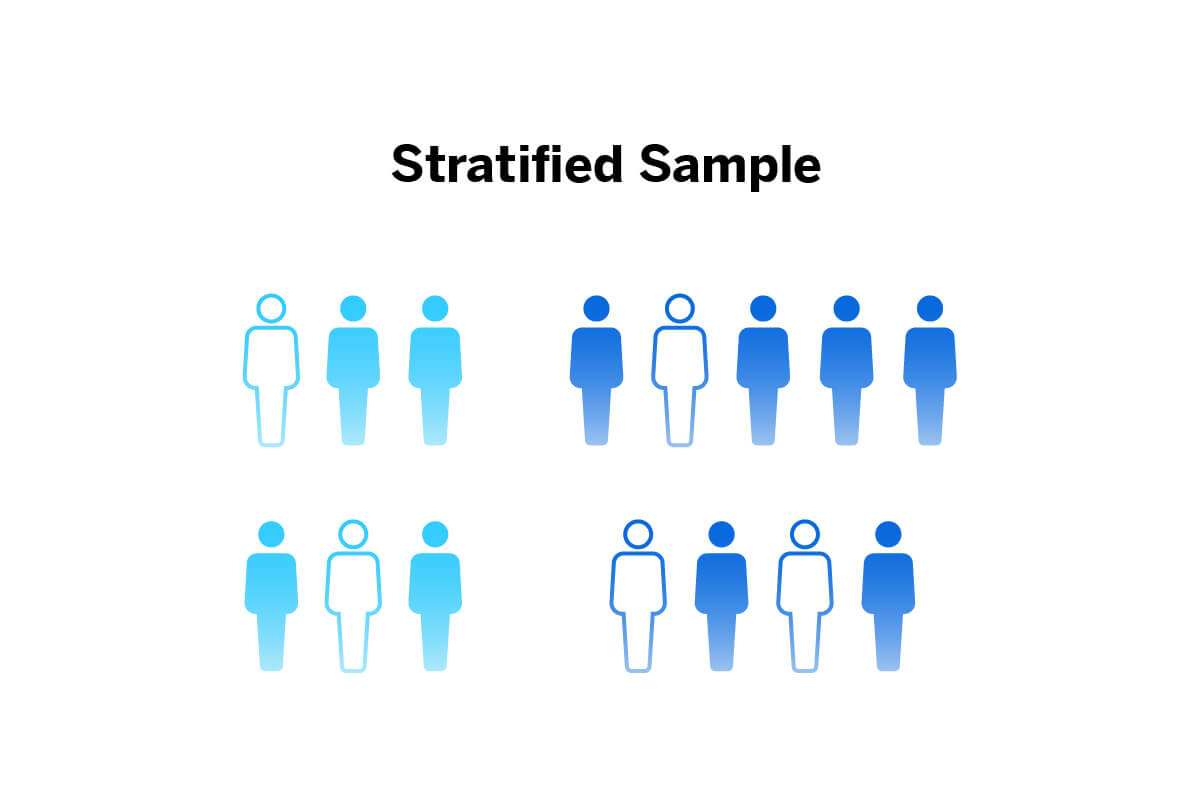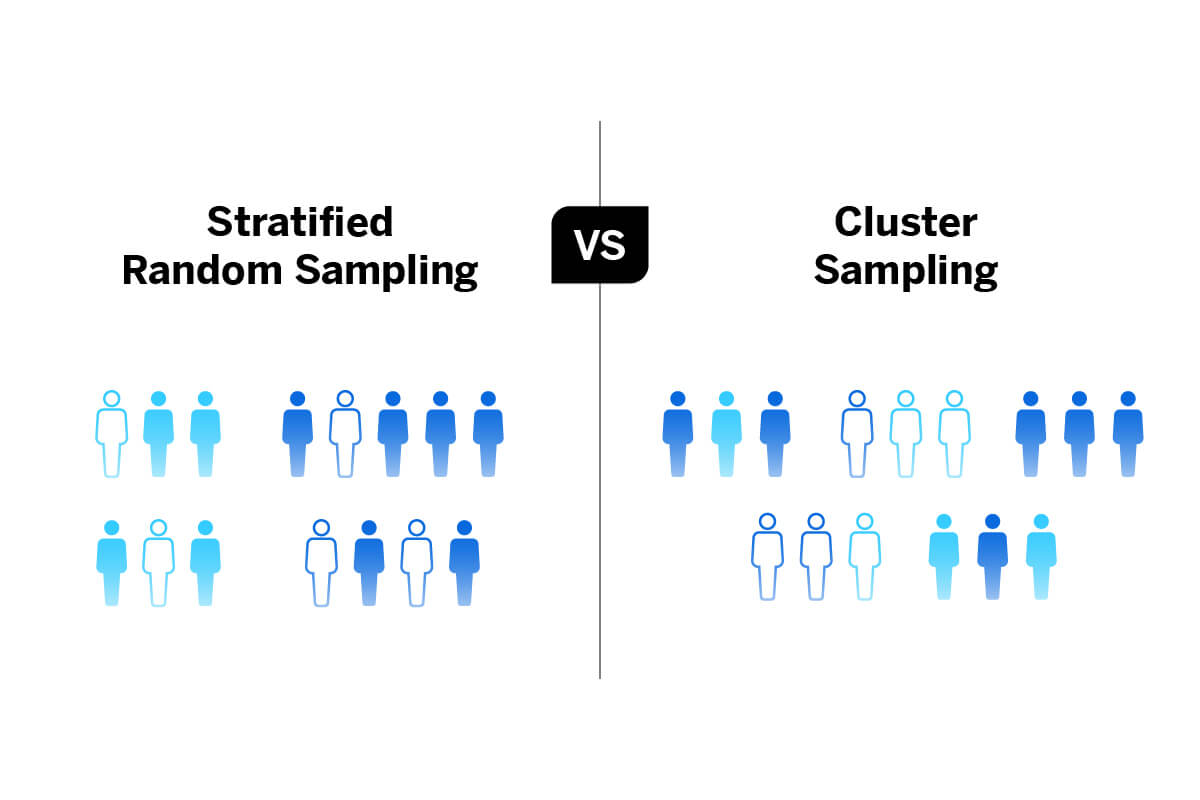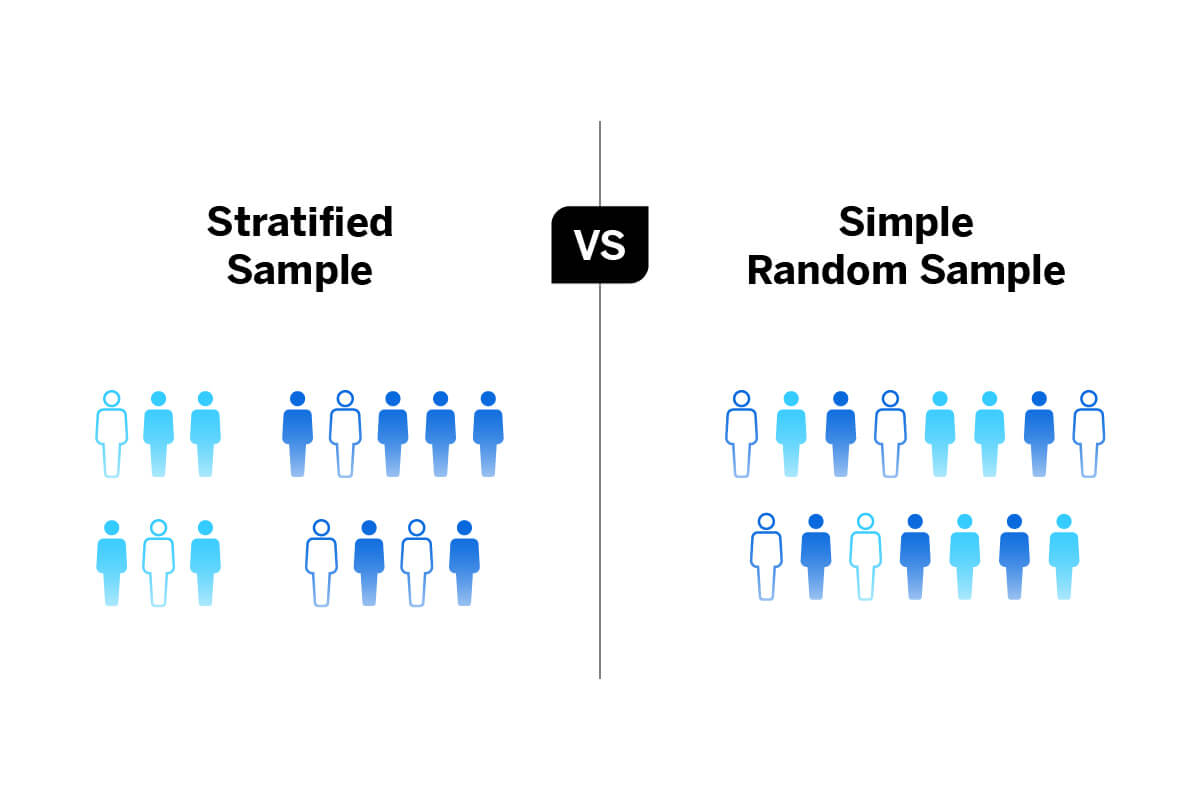When it comes to statistical surveys and getting the data you need, there’s no shortage of sampling techniques you can use.
Simple sampling, systematic sampling, quota sampling, cluster sampling — there are numerous methods for designing a sample to represent your population of interest.
Of course, each varies in accuracy, reliability, and efficiency. No two methods are the same and some are more complicated than others.
In this article, we’re going to focus on one in particular: stratified random sampling. We’re going to highlight what it is, how you can use it to your advantage, and several best-practice tips to help you get going.
Definition — what is stratified random sampling?
Stratified random sampling (also known as proportional random sampling and quota random sampling) is a probability sampling technique in which the total population is divided into homogenous groups (strata) to complete the sampling process.
Each stratum (the singular for strata) is formed based on shared attributes or characteristics — such as level of education, income and/or gender. Random samples are then selected from each stratum and can be compared against each other to reach specific conclusions.
For example, a researcher might want to know the correlation between income and education — they could use stratified random sampling to divide the population into strata and take a random sample from it.
Stratified random sampling is typically used by researchers when trying to evaluate data from different subgroups or strata. It allows them to quickly obtain a sample population that best represents the entire population being studied.
Stratified random sampling is one of four probability sampling techniques: Simple random sampling, systematic sampling, stratified sampling, and cluster sampling.
Of course, your choice of sampling technique will depend on your goals, budget, and desired level of accuracy. With this in mind, make sure to clearly outline what it is you want to achieve and try out different methods to see which work best for your research.
But for now, where do you start with stratified random sampling?
Download our free panel management guide ebook
Process — How do you do stratified random sampling?
1. Define the strata needed for your sample.
Strata are usually created based on the differences between participant’s shared characteristics – e.g. their race, gender, nationality, level of education, or age group. Researchers may or may not already have prior knowledge about a population’s shared characteristics.
2. Define your sample size.
It’s important to define the ratio numbers of your sample so it is proportionally representative of the total population (see the FAQ section below for more information).
3. Randomly select from each stratum.
After stratifying each member of the population into relevant subsections, you will apply random sampling techniques to randomly select participants from each stratum. Potential sampling methods for random selection include simple random sampling or systematic random sampling.
4. Review stratum results.
When done correctly, stratified random sampling will provide a final sample that is exhaustive (each participant of the population must belong to one stratum) and mutually exclusive (where participants don’t overlap with another stratum).
5. Combine all stratum samples into one representative sample.
For an accurate, representative sample of the entire population, you must combine all stratum examples into one. This will allow you to carry out a total population analysis.
Why do researchers use stratified random sampling?
Researchers use stratified random sampling when they are already aware of (or have become aware of) subdivisions within a population that need to be accounted for in their research. This leads to several advantages and disadvantages:
Advantages of stratified random sampling
- Stratified random sampling gives you a systematic way of gaining a population sample that takes into account the demographic make-up of the population, which leads to stronger research results.
- The method is fair for participants as the sample from each stratum can be randomly selected, meaning there is no bias in the process.
- As participant grouping must be exhaustive and mutually exclusive, stratified random sampling removes variation and the chances of overlap between each stratum.
- Lastly, it helps with efficient and accurate data collection. Having a smaller, more relevant sample to work with means a more manageable and affordable research project.
Disadvantages of stratified random sampling
- Researchers may hold prior knowledge of the population’s shared characteristics beforehand, which increases the risk for selection bias when strata are defined.
- There is more administration to do to conduct this process, so researchers must include this extra time and order.
- When randomly sampling each stratum, the resulting sample may not be representative of the full population. It is worth reviewing the results to see if the sample is proportional to the whole population.
- Once you have the final sample, data analysis of the information becomes more complicated to take into account the layers of the stratum.
Learn more about sampling and non-sampling errors
Example — Stratified random sampling in action
Let’s look at an example to bring this method to life:
If we’re investigating wage differences between genders, we can stratify a larger population into different genders (e.g. female and male) or pay grades (e.g. under £50k, £50-100k, £100-250k, over £250k).
If we choose to stratify by gender and randomly select a sample across each of the gender groups, then these samples can be compared using pay grades to explore wage gaps.
So in the example below, the total population is 15. When gender is applied to the population, we can see there are more men (9) than women (6). This gives us a sample ratio of 2:1, or a sample fraction of ⅔ men to ⅓ women.
If we want a sample size of 5 (one-third of the total population), we must randomly select participants in proportion to the size of each stratum. The number of participants selected must reflect the sample ratio.
 As a result, the final sample will have 5 randomly selected participants, which will be split by gender (made up of 2 women and 3 men).
As a result, the final sample will have 5 randomly selected participants, which will be split by gender (made up of 2 women and 3 men).
Frequently asked questions (FAQs) about stratified random sampling
What is the difference between stratified random sampling and cluster sampling?
Let’s explore cluster sampling vs stratified random sampling.
What is cluster sampling?
There are three forms of cluster sampling: one-stage, two-stage and multi-stage.
One-stage cluster sampling first creates groups, or clusters, from the population of participants that represent the total population. These groups are based on comparable groupings that exist – e.g. zip codes, schools, or cities.
The clusters are randomly selected, and then sampling occurs within these selected clusters. There can be many clusters and these are mutually exclusive, so participants don’t overlap between the groups
Two-stage cluster sampling first randomly selects the cluster, then the participants are randomly selected from within that cluster.
Multi-stage cluster sampling is a more complex process which involves dividing the population into groups before one or more clusters are chosen at random and sampled.
The main difference between stratified sampling and cluster sampling is that with cluster sampling, there are natural groups separating your population. In cluster sampling, the sampling unit is the whole cluster. Instead of sampling individuals from each group, a researcher will study whole clusters.
In stratified random sampling, however, a sample is drawn from each strata (using a random sampling method like simple random sampling or systematic sampling). Elements of each of the samples will be distinct, giving the entire population an equal opportunity to be part of these samples. Typically, natural groups do not exist, so you divide your target population into groups (stratum).
Generally, cluster sampling is much more affordable and “efficient”, whereas stratified random sampling is more precise.

What is the difference between stratified random sampling and simple random sampling?
Let’s explore simple random sampling vs stratified random sampling.
What is simple random sampling?
Simple random sampling selects a smaller group (the sample) from a larger group of the total number of participants (the population). It’s one of the simplest systematic sampling methods used to gain a random sample. Simple random sampling relies on using a selection method that provides each participant with an equal chance of being selected. And, since the selection process is based on probability and a random selection, the smaller sample is more likely to be representative of the total population and free from researcher bias. This method is also called a method of chance.
Simple random sampling involves randomly selecting data from the entire population so each possible sample is likely to occur. There are no constraints with this method and therefore no bias.
Stratified random sampling, on the other hand, divides the population into smaller groups (strata) based on shared characteristics. A random sample is then taken from each (in direct proportion to the size of the stratum compared to the population) and combined to create a random sample.

What should be the size of the sample chosen from each stratum?
The size of the sample you select will vary based on several factors:
- Scale: In general, to analyse and draw meaningful conclusions, you need a large sample that can provide you with sufficient data from the total population.
- Practicality: From a practical standpoint, if you have a larger population, you want to also have a sample size that does not require a lot of administration to collect and manage.
- Accuracy: You want a sample size that is going to accurately represent the total population to make the findings as truthful as possible.
With stratified random sampling, you will end up with a sample that is proportionally representative to the population based on the stratum used.
In most cases, this will work well. However, you may need to vary the proportions manually if you’re aware of additional information that could skew the results.
For instance, using our wage example from above, the sample has 5 randomly selected participants, which will be split by gender (made up of 2 women and 3 men). If you’re aware that the wage gap range is larger across men, then this sample may miss key information as you don’t have enough male data to support the reality.
In this case, you may want to:
Either, adjust the sample ratio to include more men – e.g. from 2:1 (6 men to 3 women) to 3:1 (8 men to 2 women).
Or, increase the sample size to include more of the population, to better reflect the wage range in the male proportion of the sample – e.g. increasing the sample size from 5 to 10.
If you’re unsure where to start, try our sample size calculator to get a good indication.
Conclusion: Where to go next to learn more?
And that’s stratified random sampling. Hopefully, you now have a good idea of how to use this probability sampling technique to aid your research and surveys.
But what if you want to simplify the process further by using a research panel?
If you’re thinking of using a research panel instead of conducting research yourself, you may way to read our in-depth eBook: The Panel Management Guide
In it, we discuss how you can:
- Ensure the right panel size
- Create the right profiling questions
- Optimize contact frequency
- Identify the key indicators of a healthy panel
- Find out how rewards and incentives can benefit your surveys
eBook: The Panel Management Guide